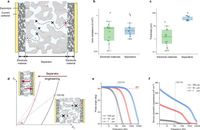In a significant leap for electrical engineering, researchers have developed a novel type of line-filtering electrochemical capacitor (LFEC) that promises to outshine traditional electrolytic capacitors in both efficiency and practicality. The key to this advancement lies in the creation of a new, highly efficient separator, known as the thread-anchor structured separator (TAS), that dramatically enhances ionic transport and minimizes resistance.
The LFECs, theoretically possessing four orders of magnitude higher specific capacitance than their electrolytic counterparts, can now operate effectively even in high-power situations thanks to this innovative separator design. The research, published on March 20, 2025, demonstrates that the TAS achieves an impressive areal capacitance of 6.6 mF cm−2 at 120 Hz and a phase angle of −80°, making it a viable alternative for applications that demand both high performance and reliability.
Historically, the practicality of LFECs was undermined by their inability to support high-power applications, typically limited to low or no-load conditions. This was primarily due to excessive ionic resistance, especially attributed to the separators used in their construction. Approximately 54% of total series resistance was attributed to conventional separators, limiting the effectiveness of LFECs in real-world applications.
To counter this, the researchers have meticulously engineered the TAS, which stands at just 3 μm thick, yet boasts a remarkably low ionic resistance of 25 mΩ cm2. In experimental settings, this new separator facilitated EUC integration that boosted capacitance by hundreds of times without compromising frequency response, achieving an unparalleled areal capacitance of 240 mF cm−2 without any degradation in filtering characteristics.
Field tests conducted using the TAS-LFECs reveal they can maintain voltage ripple suppression below 5%, even at impressive load power densities of 2.5 W cm−2. This performance not only enhances energy efficiency but also signals a new era in sustainable energy storage solutions suitable for powering demanding electronic devices like central processing units and direct current motors.
The advantage of increased capacitance while reducing footprint is twofold: the new LFECs require significantly less space compared to traditional aluminum electrolytic capacitors—saving volumes and enhancing design flexibility. For instance, when comparing equivalent capacities, the stack-integrated TAS-LFEC can achieve a footprint reduction by tenfold and a volume occupation 160 times smaller than traditional capacitors (12 mm3 versus 1963 mm3).
As articulately noted by the authors of the study, "This work opens up a perspective of separator engineering for the development of high-performance line-filtering electrochemical capacitors." This emphasizes not only the innovative nature of the TAS’s design but also the broader implications for efficiency in electronic applications.
In the pursuit of developing next-generation capacitors, the research challenges existing notions surrounding capacitor construction by showing that separators can significantly influence overall device performance. By exhibiting high tensile strength (up to 156 MPa), the TAS is both durable and effective at managing ionic flow, ensuring reliability through challenging operational conditions.
The process of creating the TAS involved integrating cellulose nanofibers with graphene oxide nanosheets, essentials in achieving the thread-anchor structure that anchors the materials while allowing ionic transport. This unique architecture means that the separator not only provides mechanical support but also facilitates rapid ion movement, a critical factor in reducing overall resistance.
Furthermore, enhanced mechanical properties prevent leakage currents from short circuits during cycling, a common issue in less sophisticated capacitor designs. The researchers conducted meticulous tests, demonstrating that the TAS-LFEC maintains performance metrics even after extensive cycling, confirming the longevity and resilience of the device.
In summary, these findings catalyze new understanding in the development of hybrid capacitor technologies, pushing the boundaries of efficiency in energy storage devices. With the enhanced capabilities provided by the innovative thread-anchor structured separator, LFECs are poised to redefine standards for high-power applications in modern electronics, paving the way for a future that maximizes both performance and reliability.

